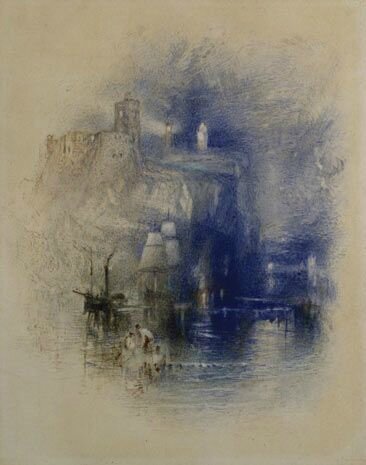Work from one of the UK's finest Turner collections on display at the Lady Lever Gallery
JMW Turner, "Margate Harbour". ©National Museums Liverpool.
LIVERPOOL.- A stunning selection of works by Romantic artist JMW Turner star in a new exhibition at the Lady Lever Art Gallery.
'Turner: travels, light and landscape' runs from 14 February to 1 June 2014 and comprises some 30 watercolours, paintings and prints which explore Turner’s journey to becoming the leading landscape painter of his generation, if not all British art.
All of the works in the exhibition belong to National Museums Liverpool and form part of one of the most outstanding Turner collections in the country.
Director of Art Galleries, Sandra Penketh said: “Turner continues to be one of Britain’s most popular and important artists. His delicate works on paper are hidden treasures of National Museums Liverpool’s collection and we’re delighted to be able to bring them out of storage and on public display.”
Themed chronologically the exhibition explores Turner’s endeavours to challenge the widely-held assumption that landscape was inferior to historical painting. It was in doing this that he produced some of the most thrilling, evocative paintings ever known.
His early career is represented with a series of prints and a selection of watercolours which reveal a topographical and measured approach, featuring stunning depictions of Linlithgow Palace, Wells Cathedral and Whalley Abbey. Covering a period between 1794-1819, Turner’s travel for much of this time was limited due the war with France but a small selection of European locations include a bustling print of Basle and a tranquil watercolour of Lake Nemi and the Town of Venzano.
The middle section of the exhibition, which spans the period 1816-1833, includes works which reflect Turner’s interest with the rapidly changing British landscape. In the watercolour Dudley (once owned by the writer John Ruskin), the dramatic intensity of a town in the throes of industrial change is set against the backdrop of a traditional landscape. Symbols of tradition and faith (the ruins of Dudley castle on the hillside and the church steeples to the left) are pictured alongside the furnaces, chimneys, boilers and canal boats of the modern age.
A radical move to a more abstract style also begins in this section. Exquisite studies of light and atmosphere demonstrate Turner’s incredible innovation and explain why he eventually became regarded as a precursor to the later Impressionist movement in Europe.
The final area explores the artist’s later works and the ‘cult’ that built around him. Looking at Turner’s commercial success it also includes two copies of works by him, Hackfall and The Fighting Temeraire.
JMW Turner,'The Doge's Palace, Venice', painted in 1840. Watercolour on paper. ©National Museums Liverpool.
JMW Turner, 'Falmouth', painted about 1812-14. Watercolour on paper. ©National Museums Liverpool.
JMW Turner, 'Light Towers of La Hève', painted around 1844. Watercolour on paper ©National Museums Liverpool.
JMW Turner, 'The Old Harbour, Naples', painted around 1818. Watercolour on paper. ©National Museums Liverpool.
JMW Turner, 'Richmond Hill', painted around 1825. Watercolour on paper ©National Museums Liverpool.
JMW Turner, 'Wells Cathedral', painted around 1795. Watercolour on paper. ©National Museums Liverpool.

/https%3A%2F%2Fprofilepics.canalblog.com%2Fprofilepics%2F1%2F0%2F100183.jpg)
/https%3A%2F%2Fstorage.canalblog.com%2F03%2F02%2F119589%2F96711876_o.jpg)
/https%3A%2F%2Fstorage.canalblog.com%2F11%2F31%2F119589%2F94773502_o.jpg)
/https%3A%2F%2Fstorage.canalblog.com%2F20%2F83%2F119589%2F94772815_o.jpg)
/https%3A%2F%2Fstorage.canalblog.com%2F26%2F72%2F119589%2F75604929_o.jpg)
/https%3A%2F%2Fstorage.canalblog.com%2F59%2F60%2F119589%2F26458628_o.jpg)









/http%3A%2F%2Fstorage.canalblog.com%2F84%2F73%2F119589%2F128782095_o.jpeg)
/http%3A%2F%2Fstorage.canalblog.com%2F03%2F16%2F119589%2F120407342_o.jpg)
/http%3A%2F%2Fstorage.canalblog.com%2F43%2F97%2F119589%2F112906870_o.jpg)
/http%3A%2F%2Fstorage.canalblog.com%2F56%2F87%2F119589%2F94341927_o.jpeg)